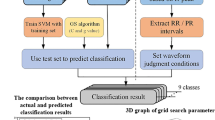Abstract
An Electrocardiogram or ECG is an electrical recording of the heart and is used in the investigation of heart disease. This ECG can be classified as normal and abnormal signals. The classification of the ECG signals is presently performed with the support vector machine. The generalization performance of the SVM classifier is not sufficient for the correct classification of ECG signals. To overcome this problem, the ELM classifier is used which works by searching for the best value of the parameters that tune its discriminant function and upstream by looking for the best subset of features that feed the classifier. The experiments were conducted on the ECG data from the Physionet arrhythmia database to classify five kinds of abnormal waveforms and normal beats. In this paper, a thorough experimental study was done to show the superiority of the generalization capability of the Extreme Learning Machine (ELM) that is presented and compared with support vector machine (SVM) approach in the automatic classification of ECG beats. In particular, the sensitivity of the ELM classifier is tested and that is compared with SVM combined with two classifiers, and they are the k-nearest Neighbor Classifier and the radial basis function neural network classifier, with respect to the curse of dimensionality and the number of available training beats. The obtained results clearly confirm the superiority of the ELM approach as compared with traditional classifiers.



Similar content being viewed by others
References
Osowski S, Linh TH (2001) ECG beat recognition using fuzzy hybrid neural network. IEEE Trans Biomed Eng 48(11):1265–1271
Hu YH, Palreddy S, Tompkins W (1997) A patient adaptable ECG beat classifier using a mixture of experts approach. IEEE Trans Biomed Eng 44(9):891–900
Khadra L, Al-Fahoum AS, Binajjaj S (2005) A quantitative analysis approach for cardiac arrhythmia classification using higher order spectral techniques. IEEE Trans Biomed Eng 52(11):1840–1845
de Chazal F, Reilly RB (2006) A patient adapting heart beat classifier using ECG morphology and heartbeat interval features. IEEE Trans Biomed Eng 53(12):2535–2543
Andreao RV, Dorizzi B, Boudy J (2006) ECG signal analysis through hidden Markov models. IEEE Trans Biomed Eng 53(8):1541–1549
Mitra S, Mitra M, Chaudhuri BB (2006) A rough set-based inference engine for ECG classification. IEEE Trans Instrum Meas 55(6):2198–2206
Siew C-K, Huang G-B (2005) Extreme learning machine with randomly assigned RBF Kernels. Int’l J Inf Technol 11(1):16–24
Xiong S-W, Liu H-B, Niu X-X (2005) Fuzzy support vector machines based on FCM clustering. In: Proceedings of 2005 international conference on machine learning and cybernetics, August 2005, vol. 5, pp 2608–2613
Mark R, Moody G (1997) MIT-BIH Arrhythmia Database 1997 [Online]. Available http://ecg.mit.edu/dbinfo.html
Minami K, Nakajima H, Toyoshima T (1999) Real-time discrimination of ventricular tachyarrhytmia with Fourier transform neural network. IEEE Trans Biomed Eng 46:179–185
Daubechies I (1998) Orthonormal bases of compactly wavelets. Commun Pure Appl Math (41):909–996
Thakor NV (1993) Multiresolution wavelet analysis of evoked potentials. IEEE Trans Biomed Eng 40(11):1085–1093
Vapnik VN (1995) The nature of statistical learning theory. Springer, New York, 187 pp
Vapnik VN (1998) Statistical learning theory. Wiley, New York
Melgani F, Bruzzone L (2004) Classification of hyperspectral remote sensing images with support vector machine. IEEE Trans Geosci Remote Sens 42(8):1778–1790
Hsu C-W, Lin C-J (2002) A comparison of methods formulticlass support vector machines. IEEE Trans Neural Netw 13(2):415–425
Wei JJ, Chang CJ, Shou NK, Jan GJ (2001) ECG data compression using truncated singular value decomposition. IEEE Trans Biomed Eng 5(4):290–299
Agresti A (2002) Categorical data analysis, 2nd edn. Wiley, New York
Park H-S, Woo S-M, Kim Y-S, Kang B-J, Ban S-W (2009) ECG pattern classification based on generic feature extraction. In: Proceedings of the 3rd WSEAS international conference on circuits, systems, signal and telecommunications (CISST’2009), pp 21–25
Nazmy TM, El-Messiry H, Al-bokhity B (2009) Adaptive neuro-fuzzy inference system for classification of ECG signals. J Theor Appl Inf Technol
Sabry-Rizk M, Zgallai W, Hardiman P, O’Riordan J (1997) Third-order cumulant signature matching technique for non-invasive fetal heart beat identification. In: IEEE international conference on acoustics, speech, and signal processing, vol. 5, pp 3781–3784
Emanet N (2009) ECG beat classification by using discrete wavelet transform and Random Forest algorithm. In: Fifth international conference on soft computing, computing with words and perceptions in system analysis, decision and control, pp 1–4
Wen C, Yeh MF, Chang KC (2007) ECG beat classification using GreyART network. Signal Process IET 1(1):19–28
Author information
Authors and Affiliations
Corresponding author
Rights and permissions
About this article
Cite this article
Karpagachelvi, S., Arthanari, M. & Sivakumar, M. Classification of electrocardiogram signals with support vector machines and extreme learning machine. Neural Comput & Applic 21, 1331–1339 (2012). https://doi.org/10.1007/s00521-011-0572-z
Received:
Accepted:
Published:
Issue Date:
DOI: https://doi.org/10.1007/s00521-011-0572-z




